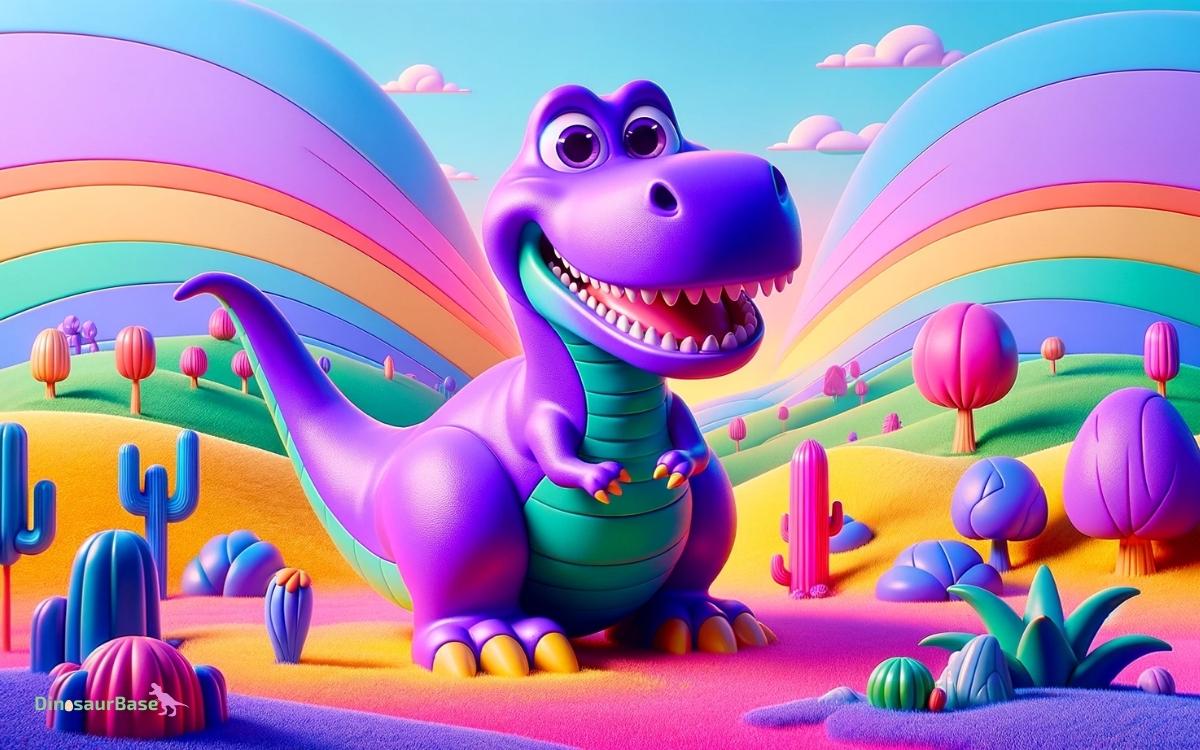What Dinosaur Is Barney? Tyrannosaurus Rex!
Barney, the beloved purple protagonist, poses a prehistoric puzzle: what dinosaur species does he represent?
While he’s widely recognized as a Tyrannosaurus Rex, his friendly demeanor and human-like qualities stand in stark contrast to the ferocious carnivores that roamed the Earth millions of years ago.
This divergence raises questions about the creative liberties taken in his design and the educational messages conveyed to children.
As we explore the origins and implications of Barney’s portrayal, one can’t help but wonder how this character has shaped our understanding of dinosaurs and their place in popular culture.


Key Takeaway
Barney’s Dinosaur Species
Barney’s portrayal as a Tyrannosaurus rex introduces a unique, amiable perspective on one of history’s most formidable carnivorous dinosaurs.
This representation diverges significantly from the traditional scientific depictions of the species, which emphasize its role at the apex of the Late Cretaceous period food chain.
By transforming a creature often associated with ferocity and predation into a friendly, benevolent character, the creators of Barney challenge preconceived notions about dinosaurs.
This approach not only humanizes the T. rex but also serves to educate and engage young audiences in paleontology.
The decision to use a Tyrannosaurus rex, a dinosaur that has captivated the public’s imagination for over a century, underscores the show’s commitment to blending educational content with entertainment.
The Real T-Rex: A Comparison
In comparing Barney to the real Tyrannosaurus rex, significant differences emerge, particularly in physical features and behavior.
While Barney represents a friendly, anthropomorphic version, the actual T-Rex was a formidable predator with distinct anatomical traits.
This analysis separates myth from reality, providing a clear view of the T-Rex’s true nature and dispelling common misconceptions.
T-Rex Physical Features
While the beloved character Barney is depicted as a friendly, purple dinosaur, the real Tyrannosaurus rex possessed distinctive physical features that set it apart from its fictional counterpart.
The T-Rex’s remarkable anatomy showcases:
- Massive Jaws and Teeth: Equipped with up to 60 large, sharp teeth, some measuring over 9 inches long, the T-Rex’s bite force is estimated to exceed 8,000 pounds per square inch, allowing it to crush bone and consume its prey efficiently.
- Strong, Muscular Legs: Supporting a bipedal stance, these legs enabled the T-Rex to achieve speeds of up to 17 mph, making it a formidable predator.
- Short, Powerful Arms: Though often ridiculed for their size, the T-Rex’s arms were incredibly strong, capable of bench-pressing several hundred pounds, aiding in holding prey or maneuvering while feeding.
Barney Vs. T-Rex Behavior
Despite their shared classification as dinosaurs, Barney’s depicted behavior starkly contrasts with the aggressive hunting and feeding habits attributed to the real Tyrannosaurus rex.
| Trait | Barney | T-Rex |
|---|---|---|
| Social Interaction | Friendly and nurturing | Solitary, possible social interactions |
| Feeding Habits | Imaginary foods, promotes sharing | Carnivorous, hunting large prey |
| Communication | Sings and teaches | Likely used roars and visual displays |
Barney’s portrayal as a lovable, gentle giant emphasizes cooperation and empathy, attributes not typically associated with the ferocious T-Rex known from paleontological evidence.
The T-Rex likely exhibited complex behaviors for hunting and possibly socializing, but certainly did not sing or engage in educational activities with younger dinosaurs.
Myth Vs. Reality
The portrayal of the Tyrannosaurus rex in popular media often diverges significantly from scientific evidence regarding its behavior and ecology. Contrary to its depiction as a relentless predator, recent studies suggest a more nuanced reality.
- Speed: While movies depict the T-Rex chasing down speedy prey, paleontologists estimate its maximum speed at about 17 mph, due to its massive size and weight.
- Intelligence: Scientific analysis indicates T-Rex had relatively high intelligence among dinosaurs, utilizing complex hunting strategies, contradicting its portrayal as a mindless beast.
- Social Behavior: Evidence suggests T-Rex might’ve exhibited social behaviors, possibly hunting in packs, a stark contrast to the solitary monster often shown.
These insights underscore the complexity of T-Rex’s life, challenging popular misconceptions and enriching our understanding of this iconic dinosaur.
Creation of a Childhood Icon
Barney’s conceptual genesis marks a pivotal moment in children’s media, transitioning from the ferocious Tyrannosaurus Rex image to a friendly, educational character.
This transformation reflects a meticulous design strategy aimed at fostering a safe and engaging learning environment for young audiences.
The evolution into an iconic status among children worldwide underscores the impact of carefully crafted characters in educational entertainment.
Barney’s Conceptual Genesis
In 1987, Sheryl Leach conceptualized Barney as a dinosaur character aimed at educating and entertaining young children through a blend of music and positive messages. This initiative was rooted in a scientific understanding of early childhood development.
The genesis of Barney was marked by several key factors:
- Developmental Psychology: Leach’s approach was informed by contemporary research in developmental psychology, emphasizing the importance of engaging content that fosters learning and emotional growth.
- Pedagogical Strategies: The incorporation of music and interactive storytelling was designed to enhance memory retention and encourage participatory learning.
- Cultural Sensitivity: Efforts were made to ensure Barney’s appeal transcended cultural and linguistic barriers, aiming for universal accessibility and relevance.
These foundational elements were meticulously woven together, forming the cornerstone of Barney’s enduring legacy as a beloved childhood icon.
Iconic Status Evolution
Shifting cultural landscapes and innovative marketing strategies propelled Barney into an iconic status among children’s entertainment figures during the late 20th century.
This transition wasn’t merely a consequence of happenstance but the result of meticulously planned branding exercises.
The creators harnessed emerging media platforms to embed Barney within the collective consciousness of a generation. They deployed an array of merchandise, live performances, and television specials, each reinforcing the dinosaur’s educational yet entertaining persona.
Analyzing viewer engagement metrics and adapting content to meet evolving preferences, the team behind Barney ensured the character’s relevance persisted.
This strategic maneuvering, underscored by rigorous market analysis, transformed Barney from a mere concept into a beloved global icon, exemplifying the intricate dance between creativity and commercial acumen in crafting lasting childhood memories.
Colorful Design Choices Explained
The vibrant purple and green color scheme of Barney the dinosaur was strategically chosen to capture the attention and stimulate the imagination of young viewers.
This design decision is underpinned by several key considerations:
- Psychological Appeal: Purple, a color often associated with creativity and imagination, and green, symbolizing growth and harmony, together create a visually stimulating contrast. This combination isn’t only appealing but also promotes a sense of balance and well-being.
- Visibility: The unique color pairing ensures Barney stands out against various backdrops, making him easily recognizable to children.
- Brand Identity: These colors have become synonymous with Barney, creating a distinctive brand identity that’s instantly identifiable, setting him apart from other children’s characters.
The choice of colors is a testament to the careful thought put into making Barney a beloved figure among children worldwide.
Educational Impact of Barney
Barney’s educational impact, while often debated, has undeniably introduced fundamental concepts to preschool-aged children through songs and storytelling. This approach harnesses the power of music and narrative to embed educational content in young minds effectively.
The table below highlights key areas of Barney’s educational contributions:
| Educational Theme | Method of Delivery |
|---|---|
| Social Skills | Group activities |
| Emotional Development | Empathy in stories |
| Cognitive Skills | Problem-solving games |
| Language Skills | Sing-alongs |
| Physical Development | Dance and movement |
This integration of learning with play and the arts reflects a comprehensive understanding of early childhood development. It emphasizes Barney’s role in promoting a well-rounded educational foundation, preparing children for more advanced concepts as they grow.
Legacy and Cultural Influence
Over the years, Barney has significantly influenced global culture and media, becoming an iconic figure in children’s entertainment.
This influence is evident in:
- Merchandise Proliferation: A vast array of Barney-themed products, from toys to educational materials, underscores the character’s deep market penetration and the commercialization of children’s characters.
- Media Presence Expansion: Barney’s adaptation into various languages and cultures highlights the universal appeal of the character’s educational messages, transcending geographical boundaries.
- Intergenerational Engagement: The character has fostered a unique intergenerational connection, with adults who grew up watching Barney now sharing the show with their children, indicating a lasting legacy in family-oriented media consumption.
This analysis reveals Barney’s enduring impact on both the commercial and cultural landscapes of children’s media.
Conclusion
Barney, the universe’s most beloved Tyrannosaurus Rex, transcends the realms of paleontology and entertainment, morphing into a global symbol of joy and education.
His vibrant purple hue, scientifically unattainable in the Cretaceous period, marks a revolutionary leap in dinosaur representation, challenging the very fabric of evolutionary biology.
The educational impact of this prehistoric giant is immeasurable, casting a long, dinosaur-sized shadow over the landscape of childhood development.
Barney’s legacy, deeply embedded in cultural DNA, continues to influence generations, proving that sometimes, science needs a touch of the impossible to truly inspire.


